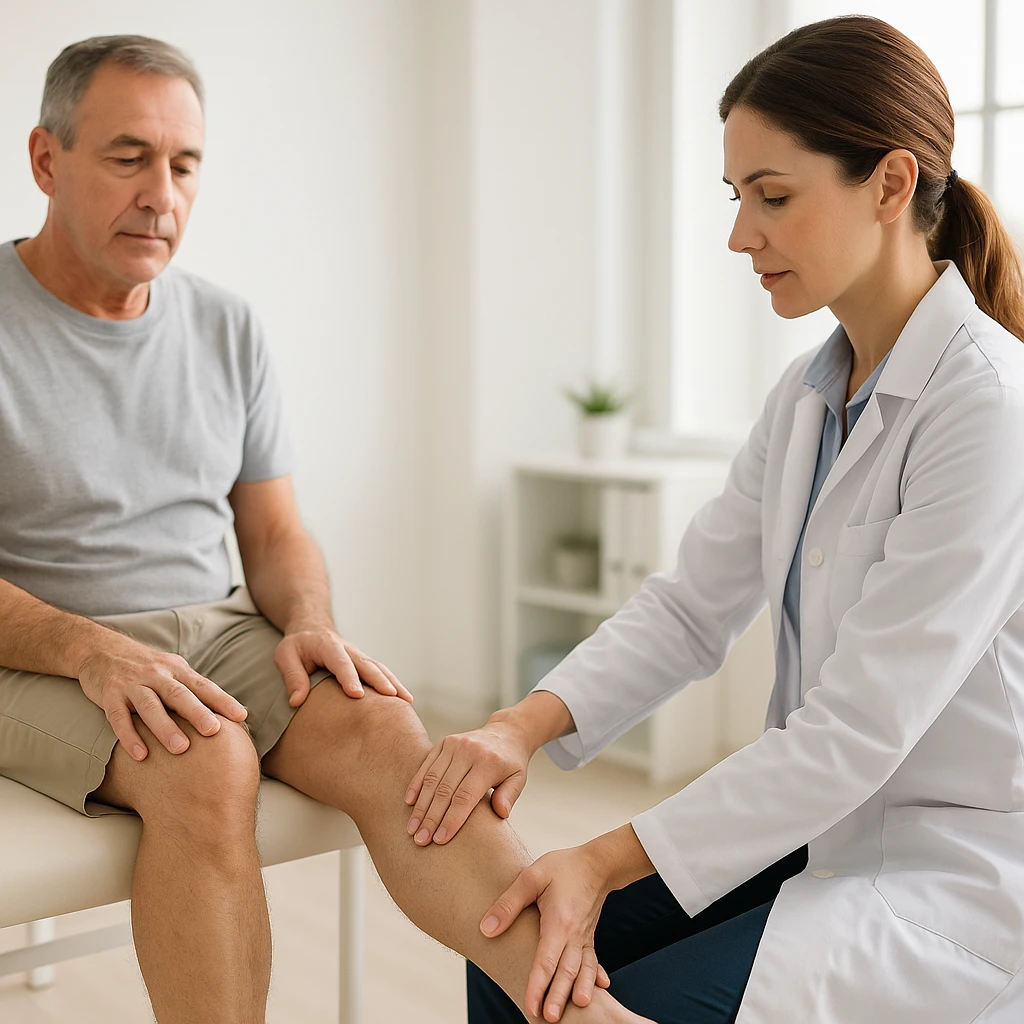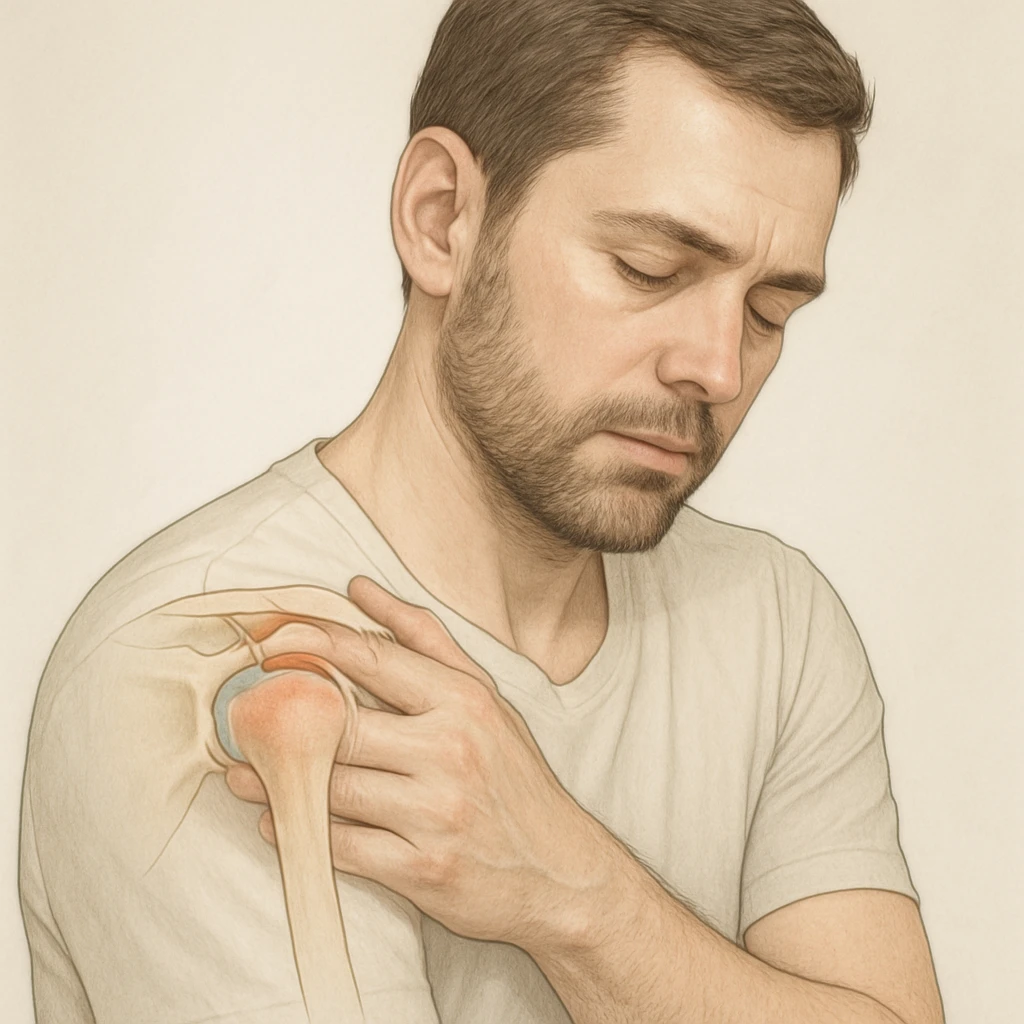Weakness in Legs: Symptoms, Diagnosis, and Treatment Options
Leg Weakness
When someone describes their legs as feeling “weak,” they may be referring to several different experiences. Sometimes, the sensation comes from being tired after physical activity or after a long day. Other times, it reflects a true loss of strength in the muscles themselves. Recognizing the difference is important, because true muscle weakness can signal an underlying medical condition that benefits from timely evaluation. Taking note of how the weakness feels, when it occurs, and whether it affects specific parts of the legs can help guide the diagnostic process.
True Weakness vs. Tiredness
| True Weakness | Tiredness/Fatigue |
|---|---|
| Loss of actual muscle strength | Strength remains normal but effort feels harder |
| Everyday movements may become physically difficult | Movements are possible but may feel tiring |
| Identified during clinical strength testing | May not show up on strength testing |
True muscle weakness means that the muscles are not able to generate the force they normally would. This is different from feeling worn out, low on energy, or lacking motivation. A person who is fatigued may still have normal strength when tested, even if their legs feel heavy or hard to move. By contrast, someone with true weakness may find that everyday tasks-such as climbing stairs, rising from a chair, or standing from a squat-become physically difficult because the muscles cannot perform as they once did.
In clinical care, strength is often evaluated by observing how a person moves and by using simple hands-on testing to assess resistance against applied pressure. These types of examinations help determine whether there is a measurable loss of power in the muscles. Understanding this distinction is a useful first step in clarifying what is happening in the body and whether further evaluation is needed.
Patterns of Weakness
- Generalized weakness: affects both legs and possibly other parts of the body.
- Localized weakness: affects specific muscle groups, such as the muscles near the hips and thighs (proximal muscles).
Weakness can affect the legs in different ways. For some people, it may be generalized, meaning both legs feel weak throughout, often alongside weakness in other parts of the body. In other cases, it may be localized, involving specific muscle groups. For example, weakness in the muscles near the hips and thighs (the proximal muscles) often shows up as difficulty standing from a seated position, climbing stairs, or maintaining balance while walking.
Noticing which movements are harder than usual and whether the weakness is equal on both sides can provide important clues about its cause. These details help guide further evaluation and ensure that the right type of testing and treatment is considered. While it is not necessary for individuals to diagnose themselves, being aware of how and where weakness appears can make discussions with a clinician more focused and productive.
Key Medical Causes of Leg Weakness
Leg weakness can arise from a wide range of medical conditions, and understanding these categories can help frame a clearer picture of what might be going on. Rather than pointing to one single cause, clinicians look at how the nervous system, muscles, and broader metabolic systems interact. The goal is not for individuals to diagnose themselves, but to recognize that different patterns of weakness can suggest different underlying processes. Evaluating leg weakness typically involves considering where the issue occurs along the pathway that allows muscles to function: from the brain and spinal cord, to the nerves, to the neuromuscular junction, and finally to the muscle fibers themselves.
Neurologic Conditions
- May involve the brain, spinal cord, or peripheral nerves.
- Weakness may affect one side or both legs, depending on the location of the issue.
- Changes in sensation, coordination, or reflexes may also be present.
Neurologic causes of weakness in legs involve the brain, spinal cord, or peripheral nerves. When the brain or spinal cord is affected, such as in a stroke or spinal cord disorder, the weakness may appear suddenly or may progress over time. The pattern may involve one side of the body, both legs, or legs more than arms. These central lesions may also be accompanied by changes in sensation, coordination, or reflexes.
Leg weakness can also result from conditions affecting the peripheral nerves, the pathways that carry signals between the spinal cord and the muscles. Peripheral nerve disorders, known as neuropathies, can lead to gradual changes in strength, sensation, and balance. The weakness may start in the lower legs and slowly progress upward, often accompanied by numbness, tingling, or altered sensation. These patterns help clinicians distinguish nerve-related weakness from weakness arising from the muscles themselves.
Muscle-Related and Neuromuscular Junction Disorders
- May affect how nerves signal muscles or the muscle fibers directly.
- Weakness may worsen with repeated activity.
- Often affects proximal muscles such as hips and thighs.
Some causes of leg weakness stem from changes within the muscles or at the point where nerves signal the muscles to contract. Neuromuscular junction diseases, such as myasthenia gravis, can lead to what is known as fatigable weakness. In these conditions, the muscles may initially work normally but tire unusually quickly, making repeated or sustained movements difficult. This can be particularly noticeable during activities like climbing stairs or lifting the legs repeatedly.
Other conditions directly affect the muscle fibers. Primary myopathies and inflammatory muscle diseases can cause weakness that often begins in the proximal muscles, such as those in the hips and thighs. People with these types of muscle disorders may find it challenging to rise from a seated position, walk uphill, or maintain balance. The weakness may progress slowly or more rapidly, depending on the specific condition and its underlying mechanisms.
Systemic and Metabolic Contributors
- Can involve thyroid or electrolyte imbalance affecting muscle function.
- May develop gradually across multiple muscle groups.
- Some medications or toxins may affect nerves or muscle fibers.
In some cases, leg weakness is related to broader metabolic or endocrine factors. Disorders such as thyroid disease or imbalances in key electrolytes can alter muscle function and strength. These conditions may develop gradually and can affect multiple parts of the body. Addressing the underlying systemic issue often leads to improvement in muscle performance.
Medications and toxins can also play a role. Some medications are known to affect either the nerves or the muscles and may lead to weakness over time. Recognizing when symptoms began and whether they coincide with new medications or exposures can be an important part of the evaluation process. Identifying and adjusting these contributors can be a meaningful step in managing leg weakness.
Peripheral Neuropathy and Its Role in Leg Weakness
Peripheral neuropathy refers to conditions that affect the nerves outside the brain and spinal cord. These nerves carry the signals that allow muscles to contract and also provide sensation from the skin and tissues. When these nerves are damaged, the communication between the nervous system and the muscles becomes less effective. This can lead to a combination of muscle weakness, changes in sensation, and difficulties with coordination. The effects are often most noticeable in the lower legs and feet because the nerves that supply these areas are long and more vulnerable to injury. Understanding this connection helps explain why neuropathy can make walking, maintaining balance, and performing daily activities more challenging.
How Nerve Damage Leads to Weakness
- Nerves send signals that control muscle strength and movement.
- Damage can reduce or disrupt these signals, leading to weaker muscle function.
- Lower-leg nerves are often affected first, making foot and ankle movements more difficult.
Muscles rely on nerves to send clear and consistent signals that tell them when and how strongly to contract. When nerve function is disrupted, muscles may not receive the full signal needed for normal movement. Over time, this reduced signaling can lead to weakened muscle performance, even if the muscles themselves are otherwise healthy. In some forms of neuropathy, the damage primarily affects the nerves that control the lower legs and feet. This can result in difficulty lifting the front of the foot while walking or maintaining steady steps. These changes may appear gradually and can be subtle at first, becoming more noticeable over time.
Symptoms That Suggest Neuropathy
- Numbness or reduced sensation in the feet
- Tingling or burning discomfort
- Unsteadiness or difficulty keeping balance while walking
- Weakness that begins in the lower legs and progresses upward
Peripheral neuropathy can affect movement, sensation, or both. Some people experience numbness or a reduced ability to feel temperature or touch in their feet. Others report tingling, burning sensations, or discomfort that may worsen at night or after prolonged standing. Because the nerves involved in balance and muscle control are affected, walking may feel unsteady or less coordinated. Diabetic and toxic neuropathies commonly cause distal leg weakness with sensory loss and gait instability. These symptoms may make activities like climbing stairs, walking on uneven surfaces, or standing for long periods more difficult.
Not everyone experiences neuropathy in the same way. For some, symptoms begin slowly and progress over time. For others, the changes may be more noticeable in daily tasks, such as needing to hold onto railings or feeling less confident while walking.
Importance of Early Management
- Early recognition can help slow progression.
- Managing contributing conditions, such as diabetes, can help protect nerve function.
- Supportive strategies can help maintain balance and reduce fall risk.
Early identification and control of underlying causes can slow neuropathy progression. For individuals with neuropathy related to conditions such as diabetes or medication effects, addressing these contributing factors can help prevent further nerve damage. Recognizing symptoms early also allows for timely support aimed at maintaining mobility and reducing the risk of falls. This may include adjusting daily routines, modifying environments for safety, or working with clinicians to support nerve and muscle function.
Taking note of symptom patterns and discussing them with a clinician can help determine whether neuropathy is contributing to leg weakness. Even gradual changes are worth mentioning, as early attention can make a meaningful difference in how symptoms are managed over time.
Evaluation, Urgent Warning Signs, and Treatment Approaches
When leg weakness appears, the first priority is to understand its pattern, speed of development, and associated symptoms. This helps clinicians determine whether the situation is urgent and what underlying processes may be responsible. Some cases develop slowly and require outpatient evaluation, while others are emergencies that need immediate medical attention to prevent permanent harm. A structured approach guides both diagnosis and care, ensuring that treatment addresses both the strength of the muscles and the safety and mobility of the person affected.
Red Flags Requiring Immediate Care
- Sudden or one-sided leg weakness
- Weakness with new back pain and bowel or bladder changes
- Weakness accompanied by difficulty breathing, speaking, or swallowing
Certain symptoms signal that leg weakness may be caused by a serious and rapidly advancing condition. Acute onset focal weakness or new unilateral leg weakness may indicate a possible stroke and requires emergency assessment. If weakness develops quickly along with new back pain or changes in bladder or bowel control, this may suggest spinal cord compression, which is a medical emergency. Likewise, weakness accompanied by difficulty breathing, weakness of the face or tongue, or changes in speech may point to a neuromuscular junction disorder that can affect the muscles responsible for breathing and swallowing. In these situations, immediate medical evaluation is essential to prevent further deterioration.
When such red flags appear, calling emergency medical services is appropriate. Prompt recognition allows clinicians to perform tests and initiate treatment without delay, improving the chance of recovery and protecting vital functions.
How Clinicians Diagnose the Cause
- History and physical examination to define pattern and severity
- Basic laboratory testing when appropriate
- MRI or other imaging if central nervous system involvement is suspected
- EMG/NCS to distinguish nerve vs. muscle causes
When leg weakness is not an emergency, clinicians begin with a detailed history and physical examination. They assess how the weakness started, how it has changed over time, and whether it affects one side or both. The physical examination evaluates strength, reflexes, sensation, and coordination to help determine whether the issue involves the muscles, nerves, or central nervous system.
Initial workup is guided by localization and may include basic labs such as electrolyte levels, thyroid studies, and creatine kinase to look for metabolic or muscle-related contributions. If further clarification is needed, imaging such as MRI may be used to evaluate the brain or spinal cord. Electrodiagnostic studies (EMG/NCS) help differentiate neuropathic from myopathic processes by examining how nerves and muscles function together. These evaluations help ensure that treatment is targeted to the correct underlying issue.
Treatment and Support
- Address the underlying medical cause when identified
- Use physical therapy to support strength and coordination
- Incorporate fall-prevention strategies and assistive devices if needed
Once the cause of leg weakness is identified, treatment focuses on addressing that specific condition. Treating the identified underlying condition can improve or stabilize strength. For example, managing endocrine imbalance, adjusting medications that may be contributing to weakness, or treating inflammatory muscle conditions may all be part of the plan.
Supportive care is also key to maintaining safety and mobility. Physical therapy can help strengthen muscles, improve gait, and support balance. Fall prevention strategies are often discussed, as weakness can make walking and daily activities more challenging. Assistive devices such as canes or walkers may provide additional stability when needed, and small changes in the home environment can help reduce the risk of falls.
Referral to a specialist, such as a neurologist, is recommended for progressive, unexplained, or focal neurological deficits, or when specialized testing is needed to clarify the diagnosis. These referrals help ensure that individuals receive the most appropriate evaluation and care, especially when rare or complex neuromuscular disorders are being considered.
- True muscle weakness is a measurable loss of strength and is different from general tiredness or low energy.
- Weakness in legs may be generalized or limited to specific muscle groups, such as the hips and thighs.
- Neurologic causes of leg weakness can include stroke, spinal cord disorders, and peripheral nerve disease.
- Neuromuscular junction disorders may lead to fatigable leg weakness that worsens with repeated activity.
- Primary muscle diseases can cause proximal leg weakness, often making movements like rising from a chair more difficult.
- Thyroid imbalance or electrolyte disturbances can gradually contribute to weakness in the legs.
- Sudden one-sided leg weakness may indicate a stroke and requires urgent medical evaluation.
- Diabetic and toxic neuropathies often cause leg weakness with numbness, sensory changes, and gait instability.
Frequently Asked Questions
Is feeling “weak legs” the same as being tired?
No. Feeling tired often means the muscles still have normal strength but movement feels more effortful. True weakness means the muscles cannot generate their usual force, which can make everyday activities physically harder.
Why does leg weakness sometimes affect the hips and thighs first?
Some muscle and nerve conditions affect the proximal muscles near the hips before others. This can show up as difficulty climbing stairs, standing from a chair, or maintaining balance.
Can nerve problems cause leg weakness even if the muscles are healthy?
Yes. When peripheral nerves are damaged, the signals that allow muscles to contract become weaker or delayed. This can lead to muscle weakness, coordination challenges, and changes in sensation.
What does numbness or tingling along with leg weakness mean?
Numbness, tingling, or burning sensations often suggest involvement of the peripheral nerves. These symptoms can occur in conditions such as diabetic or toxic neuropathy, where both strength and sensation may be affected.
Are sudden changes in leg strength serious?
Yes, especially if the weakness appears on one side of the body or develops very quickly. Sudden unilateral leg weakness may be a sign of stroke and requires urgent medical evaluation.
How do clinicians figure out the cause of leg weakness?
Clinicians look at how and when the weakness began, where it is located, and whether sensation or reflexes are also affected. Testing may include blood work, imaging, or electrodiagnostic studies to help distinguish nerve-related from muscle-related causes.
Can metabolic or endocrine issues lead to leg weakness?
Yes. Changes in thyroid function or electrolyte balance can affect muscle performance over time. These conditions may cause gradual, widespread weakness and are often detectable with laboratory testing.
What role does physical therapy play when leg weakness is present?
Physical therapy can support mobility, balance, and muscle coordination. It is often used alongside treatment of the underlying medical cause and can help reduce the risk of falls.













